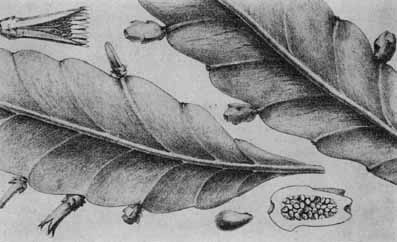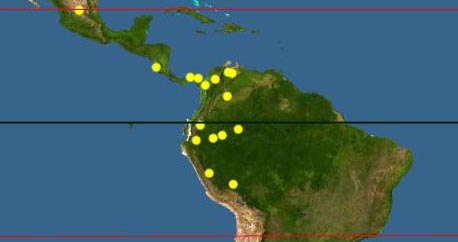Some remarks about...
**** WITTIA AMAZONICA ****
**** or DISOCACTUS AMAZONICUS ****
** or PSEUDORHIPSALIS AMAZONICUS **
__________________
PAGE 3/3
____________________
WITTIA AMAZONICA IN NATURE
I wanted to see a little more clearly in my successes and my failures, so, I tried to see where and in which biotopes Wittia amazonica was growing and I consulted some reference books as well as an Internet source.
1) In "The Cactaceae" (1919-1923) (vol. 4)
of Britton & Rose, the Wittia genus (from N. H. Witt, Brazilian
collector) is already described with two species:
Wittia amazonica and Wittia panamensis. It is mentioned that a way to differentiate
the two species is the aspect of the fruit: rough with small tubers for Wittia
amazonica, smooth for Wittia panamensis. Wittia amazonica is illustrated on
the plate below :

The first species is localized in the North-East of Peru, close to the Brazilian border and the second in Panama, in Colombia and perhaps in Venezuela. These localizations suggest a high hygrometry and also high minimal temperatures.
2) Ralf Bauer (2003) in "A synopsis of the tribe
Hylocereeae F.Buxb. Cactaceae Systematics Initiatives 17" classifies
Wittia in the Pseudorhipsalis genus and distinguishes three subspecies of
Pseudorhipsalis amazonica : Pseudorhipsalis amazonica ssp. amazonica, Pseudorhipsalis
amazonica ssp. panamensis
and Pseudorhipsalis amazonica ssp. chocoensis.
We must note that the bluish colouring at the tip of the petals occurs only in the last two subspecies and never in the first one.
The first subspecies is localized in the low altitude areas : 120-400 (- 1400) m of the rainy tropical forests of the Western part of Amazonia, in Colombia, in Ecuador, in Peru and Brazil. The second subspecies is localized in the rainy forests of Costa Rica, Panama, Colombia and Venezuela, at an altitude of 50-400(-1550)m. The third subspecies is located in Colombia, in areas mostly of low altitude, 20-280 (- 990) m in very wet rainy tropical forests, where annual precipitations range from 7000 to 8000 millimeters. Thus we also note here the conjunction of a high hygrometry and equally high minimal temperatures.
3) The website of Discover Life proposes a map of the various localizations of Wittia amazonica which makes it immediately possible to have a general view and to confirm the data of the two previous books. I was largely inspired by this site for the map below and I invite you to consult it if you wish to have more details : (you may click on the link of the website at the end of the article.) Red lines account for the two Tropics and a black line for Ecuador. The yellow points are localizations of Wittia amazonica, detailed on the Discover Life site.

Except for the Mexican localization which is the most septentrional one and which isn't mentioned in the previous books although it is oldest (1858), all the others mostly correspond to very wet zones of low altitude, between 100 and 300 m.
AMONG OTHER REMARKS, ALL THIS SHOWS US THAT...
Wittia amazonica grows in very wet areas where the minimal temperature seems to be approximately 15°C or more.
And this led to a remark which should have been obvious to me from the beginning : when a plant is cultivated, it's better to get information about its living conditions in its biotope immediately to expect the best possible results.
But a plant is also sometimes able to adapt to exceptional conditions (I refer here to the incident of resistance to cold !!)
And for those who were brave enough to read me up to now, here are the photographs of the flowering of my Wittia amazonica, starting from the formation of the buds, until complete blossoming; it took approximately 3 to 4 weeks from the first photograph to the last.
Just click on the following link to see all the photographs.
PHOTOGRAPHS, FROM THE FORMATION OF THE FLORAL BUDS UNTIL COMPLETE BLOSSOMING
_______________________________________________________________________
Bibliographical and Web sources used to write these pages:
* Britton N.L. & Rose J.N. (1919-1923) : "The Cactaceae, vol. 4" Carn. Inst. Washington.
* Bauer Ralf (2003) : "A synopsis of the tribe Hylocereeae F. Buxb. Cactaceae Systematics Initiatives 17".
* Discover Life : website : http://www.discoverlife.org/
* The French-speaking blog of my friend Michel Monnier : "Xeroflore"
* Library on line of the French-speaking website : Le Cactus Francophone : http://www.cactuspro.com/biblio/
* Alain Laroze : "Why are there not cacti with blue flowers ?" : http://www.cactuspro.com/faq.en.php#28
________________________________________________________________________
BACK TO PAGE 2/3 BACK TO PAGE 1/3
_________________________________________________________________________